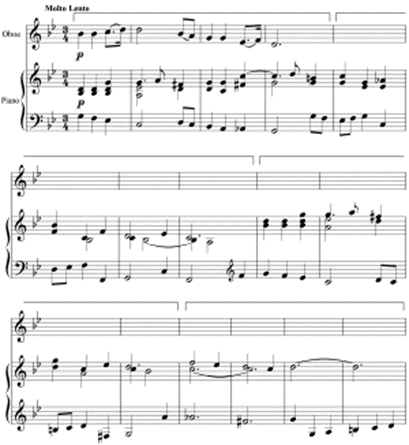Grade 7 Composition Types
In the ABRSM grade 7 music theory exam, there is a choice of compositions, but the type of question is different in each case.
The questions are numbered as 3a and 3b.
Question 3a
Question 3a asks you to complete the solo part to fit a given piano accompaniment.
Normally you will be asked to complete about two full staves-worth, and you will be given about 2-4 bars of the solo part to start you off.
The idea behind this question is that you are being tested on: your ability to understand the harmonic structure from the piano part, and your ability to create a melody which fits nicely with that accompaniment.

The composers used for this question are from the late classical to Romantic eras.
You do not need to add any performance directions when you do this question.
Phrase marks are drawn over the staves for you, to help you see the melodic structure. You do not have to keep to the suggested phrase lengths, but remember, they are there to help!
You are not given a choice of instrument for this question, but you can expect it to be a normal standard orchestral instrument. Your melody needs to be written at concert pitch.
Question 3b
Question 3b is completely different – there is no given piano accompaniment, and the style of the composition is normally much more modern than in question 3a. You are given 1 or 2 bars as a given opening for a solo instrument, with a choice of two instruments. This question is more similar to the composition questions set at grade 6, although a more sophisticated composition would be expected at this grade.
If you choose this question, you will need to add performance directions.
Your piece should be at least 8 bars long, and although the question doesn’t stipulate that you need to include any modulation, you should if you want to achieve top marks.
As with question 3a, you need to stick to the style of the given opening.
Occasionally in this question, you are also given a harmonic progression to work from – a series of chords written out, showing you which bars they should fall in. In this type of question, you’ll also be given an opening of 1 to 2 bars, but whether you choose to use it or not is up to you.
The melody you write will need to fit the chords which are shown in the progression, with the addition of non-harmony notes, like passing notes or chromatic alterations, added in to make the tune more musical.
Which question should you choose?
Many students choose question 3b, especially when there is no chord progression given, because at first sight it seems like the easier option. Because there is no piano part to fit your melody with, it can seem as though there is less you can get wrong.
In actual fact though, the ABRSM has said that candidates who choose question 3a tend to get better marks.
In 3a, the structure is already made for you, whereas in question 3b, you need to make a structure yourself, and many students fail to achieve this.
Although 3b gives you a lot more freedom, sometimes it is difficult to know what to do with that freedom.
The best approach is to have a go at a few practice questions of both types, to see which you manage with best.